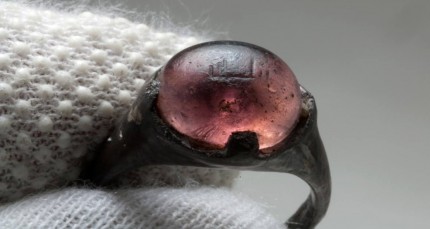
A finger ring discovered in a grave in the Viking trading center of Birka on Björkö Island, Sweden, in the 19th century is the only ring with an Arabic inscription ever found at a Scandinavian archaeological site. It was unearthed by archaeologist Hjalmar Stolpe during his two-decade-long (1872–1895) excavation of the Birka burial grounds in the grave of a woman dating to around 850 A.D. Although the skeleton was completely decomposed, the grave goods — two oval brooches, one with a needle case hanging in a chain, one with a pair of scissors underneath that were probably attached with a string, an equal-armed brooch, a row of glass, rock crystal and carnelian beads — and remains of clothing — a flax undergarment and a blue wool garment — identify the deceased as female.
The ring was found inside the wooden coffin where her chest would have been, next to the scissors under the right oval brooch. Either it too was connected to the brooch with a now-decayed string, or the woman’s hands may have been placed on her chest when she was placed in the coffin. It is made of silver and set with a translucent purple cabochon stone engraved with Arabic Kufic script. Rings of similar design have been found in Viking graves before, including three in graves at Birka, and in Eastern European graves of the period, but none of them have inscriptions.
The ring is part of the collection of the Swedish History Museum in Stockholm now, but it has never been scientifically analyzed. To answer some questions about its material and construction, the ring was recently subjected to non-invasive examination while a replica took its place on display. Researchers studied the ring under a standard optical stereomicroscope and a scanning electron microscope (SEM) equipped for elemental analysis which would allow them to determine the metal content and identify the stone without having to take any destructive samples.
They found that the museum’s interpretation of the ring was wrong on several counts. The museum’s inventory catalogue describes its as a gilded silver signet ring set with an engraved violet amethyst. It’s not gilded silver. It is a high-grade silver alloy consisting of 94.5% silver and 5.5% copper. The stone is not an amethyst. It is not even a stone. It’s colored soda-lime glass, which isn’t to say it was cheap or a fake because glass was a prized luxury import in Viking Scandinavia. The inscription, engraved in an angular form of Arabic Kufic script that was in use from the 7th century through the 12th, reads, researchers believe, “il-la-lah”, or “For/to Allah.” Interpretation is challenging due to the stylized script, so it could be saying something else, but Allah is definitely a part of it, which means that it’s not a signet ring.
The ring shank was at some point in its history broken in three places and then glued back together. This couldn’t have been done before the burial because the glue is a polymer rather than an animal glue and the latter wouldn’t have been strong enough to keep the ring together anyway. It’s more likely that it was either found broken or damaged in the excavation and then glued back together. There is no documentation of any such action being taken.
Researchers also found that the metal surface of the ring bears parallel striations that are likely file marks left by the original maker when he filed the ring to remove flash and mold lines left by the casting process. There are file marks on the prongs as well, which means the filing was done before the glass was added. These marks would normally be eroded away by usage. The fact that they’re still everywhere on the ring body indicates the ring was barely used before being buried. That suggests it didn’t gradually wend its way to Sweden trade by trade, but rather got from the maker to the deceased with no or very few other owners in between.
The glass, on the other hand, has the scratches and dents of moderate use. It may have been recycled from an older piece, or it may just be the victim of how far it juts out from the ring and of glass’ inherent softness compared to the silver of the ring body.
Nobody’s disappointed that the ring isn’t gilded and the stone isn’t a gemstone. The value of this ring is not in its materials, but in the historical significance of the inscription which connects it to the Islamic world. In fact, gilding would have obscured the file marks and those marks are key archaeological evidence of direct or at least very close interaction between Viking Scandinavia and the Caliphate. There are historical records documenting direct contact (The 13th Warrior, man! Just because it’s a bad movie doesn’t mean it’s not awesome.) and archaeological evidence of direct contact in Spain and Eastern Europe, but not in Scandinavia itself. That’s what makes this ring so important.